Hard water is a common issue in over half of the UK, causing damage to appliances like boilers, washing machines, and kettles. This can lead to costly repairs and reduced efficiency. Water softeners and conditioners are essential tools for combating limescale and improving water quality. Below, we explore the pros and cons of using these solutions to protect your home and appliances.
Hard Water Problems and Appliance Damage
Hard water contains dissolved lime, calcium, and magnesium. As water enters your home, these minerals settle on heating elements and other surfaces, forming stubborn limescale.
Limescale buildup affects more than just heating elements. Any appliance or system that uses water, such as central heating, shower heads, or taps, is at risk. As limescale accumulates, appliances become less efficient, driving up energy costs and shortening their lifespan.
For example, a heating element with just 5mm of limescale is 20% less effective, leading to higher bills and faster wear and tear.
The solution? Treat your water at the source to reduce or eliminate these minerals, preventing damage before it starts. Installing a water softener or conditioner can protect your appliances and save you money.
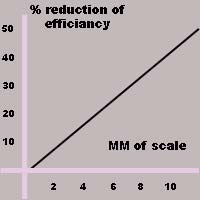
Reduction in efficiency with the presence of hard water
How Long do Water Softeners Last?
Generally, a well-maintained and cared for water softener can last between 10 and 20 years. The exact lifespan depends on the type of water softener, the quality of the water it treats, and how well it is actually maintained.
Salt-Based Water Softeners: Generally the most common type of water softeners and typically last about 10 to 15 years. To ensure as long a life as possible, it’s important to regularly maintain the system, that includes cleaning the brine tank, replenishing the salt supply, and occasionally checking and replacing the resin bed.
Salt-Free Water Conditioners: These systems generally have a longer lifespan, often exceeding 20 years. As they use techniques like Template Assisted Crystallization (TAC) they typically require less maintenance. Because they lack moving parts and don’t rely on salt, there is less wear and tear, meaning a longer lifespan.
The quality of your water supply also affects how long your water softener lasts. Areas with very hard water can place additional strain on the system, potentially shortening its life. Regular monitoring and maintenance can help resolve any issues before they lead to more serious problems that affect the units lifespan.
Is There any Risk Drinking Softened Water?
Many people use water softeners to improve their water quality by reducing hardness and preventing scale buildup. However, you might wonder whether drinking softened water is safe. The answer depends on the type of water softener you use and your specific health considerations.
Salt-Based Water Softeners: These are the most common type of water softeners and work by replacing minerals like calcium and magnesium with sodium ions. As a result, softened water contains much higher levels of sodium. While this is generally safe for most people, individuals on low-sodium diets or those with certain health conditions, such as high blood pressure or kidney issues, should be very cautious. Drinking high-sodium water regularly could potentially contribute to health problems, so it’s often recommended to use a separate, untreated tap for drinking and cooking water.
Salt-Free Water Conditioners: These systems do not add sodium to the water. Instead, they prevent scale formation by altering the structure of hardness minerals so they don’t adhere to surfaces. Since salt-free systems don’t affect the water’s mineral content significantly, drinking water from these systems is generally safe for everyone. They are a suitable option if you are concerned about sodium intake but still want to prevent limescale buildup.
So, on the whole, although for the average healthy person, drinking softened water from either system should be fine, due to the elevated salt levels associated with salt-based systems and its associated health risks, we would always recommend having a separate water supply for cooking and drinking with these systems.
However, with salt-free systems, as they don’t alter the physical properties of the water, drinking any treated water should be absolutely fine.
Water Softeners vs. Water Conditioners
While water softeners and water conditioners are often confused, they work differently to combat mineral deposits and limescale buildup.
First, let’s define each. A water conditioner doesn’t remove minerals from water; it keeps them from settling and forming limescale using methods like magnetism, electrolysis, or electrical charges. The water remains hard but is less likely to cause damage.
On the other hand, a water softener removes minerals through ion exchange, replacing them with sodium chloride (salt), effectively softening the water.
Benefits of Treating Hard Water
Compare the two heating elements below. The top one, unprotected from hard water, is covered in limescale. The bottom element, treated with conditioned water, shows no deposits.
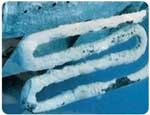
Element with no hard water protection
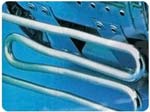
Heating element protected by water conditioning
Just 5mm of limescale can reduce appliance lifespan by a year. For example, a washing machine designed to last 10 years could fail in 2 without treatment. By conditioning your water, you can avoid frequent, costly replacements.
Other appliances like kettles, dishwashers, and coffee makers also benefit from limescale-free water, operating more efficiently and lasting longer.
Your boiler and heating system will also run much smoother and more cost-effectively when protected from mineral buildup. Being one of the costliest items in the home it is absolutely imperative that it does and you will certainly notice this in any savings you make. This not only lowers your energy bills but also reduces your environmental impact.
What Are the Downsides of Water Softeners?
While water softeners offer many benefits, including reducing limescale buildup and extending the lifespan of appliances, they also come with some downsides. Here follows some of the most common of these:
Increased Sodium Levels: This is arguably the most significant concern with traditional salt-based water softeners. These systems replace minerals like calcium and magnesium with sodium (salt). Too much salt for anyone can cause serious health issues over time so water filtered by such systems should not be used for drinking and cooking.
Cost: Water softeners can be a significant investment. Not only due to install and purchasing costs, but also ongoing costs for salt and maintenance. Salt-based systems, in particular, require regular refilling of salt and occasional servicing.
Environmental Impact: Traditional water softeners can have environmental implications. The regeneration process of salt-based systems involves flushing excess salt into the wastewater, which can be harmful to the environment. This waste can contaminate groundwater and affect local ecosystems.
Maintenance Requirements: Water softeners require regular maintenance to ensure they function at optimal levels. Salt-based systems need periodic refilling of salt, cleaning of the brine tank, and occasional replacement of parts like the resin bed. Neglecting maintenance can lead to decreased efficiency and potentially costly repairs.
Costs Involved with Installing Water Softeners
Installing a water softener can significantly improve your home’s water quality, but it’s important to understand what initial and ongoing costs are involved. These costs can vary based on the type of system you choose, your home’s size, and additional installation needs. Here’s a breakdown of what you can expect to pay:
Initial Purchase Cost: The cost of purchasing a water softener system depends on its type and capacity. Salt-based systems, which are the most common, typically range from £400 to £1,500. The price varies based on the brand, features, and capacity of the system. Salt-free water conditioners often cost between £150 and £1,200, however they don’t require salt or too much ongoing maintenance.
Installation Costs: Correct installation is crucial for ensuring your water softener functions correctly. Paying an installer generally ranges from £150 to £500, depending on the complexity of the job and local labor rates. Some salt-free systems can also be easily installed on a DIY basis.
Ongoing Maintenance Costs: Maintaining a water softener, especially salt-based systems involves regular maintenance to keep them running efficiently. For these systems, you’ll need to budget for salt refills, which can cost around £100 to £200 per year. Additionally, you may need to replace components like the resin bed every 5 to 10 years, which can cost between £200 and £500. Salt-free systems typically require less maintenance, but you should still monitor them regularly.
Additional Costs: Additional costs can vary depending on system e.g. if your water softener affects drinking water quality, you might need to install a separate drinking water filter for drinking and cooking. This can add another £100 to £300 to your total expenses. Also, depending on your existing plumbing, installation costs may be affected by this.
How Long Do Water Softeners Last?
On average, most water softeners last between 10 to 15 years, however, this lifespan can vary based on the type of system you choose. Salt-based water softeners, which are the most common, generally have a lifespan of around 10 to 15 years.
Salt-free systems, often regarded as more durable, can also last 10 to 15 years.
Despite these fairly impressive longevity figures, the obvious major effect here is how well they’re maintained. If looked after and maintained well, this figures are more than achievable, but if not then they are likely to fail well before!
Types of Water Softeners and Conditioners: How They Work
The best way to combat hard water is by installing a water softener or conditioner to reduce or eliminate the minerals that cause limescale.
Below, we outline the main types of water softeners and conditioners, explaining how they work and their effectiveness.
Salt-Based Water Softeners
Salt-based water softeners, using ion replacement, are a popular and effective method for softening water. These systems remove minerals like calcium and magnesium from hard water, replacing them with sodium ions (salt).
The process begins at the point where your main water supply enters your home. Here, the water softener is installed. As water flows through a tank filled with negatively charged resin beads, the positively charged minerals bind to the beads and are replaced by sodium ions, resulting in softened water.
Over time, the resin beads become saturated with minerals and require cleaning through a regeneration process. During this cycle, a brine solution created from salt blocks is flushed through the beads, exchanging the mineral ions for sodium ions, effectively recharging the system. The waste water is then drained away.
While highly effective, salt-based systems have some drawbacks. Regeneration consumes a significant amount of water (up to 8 litres) and salt, potentially costing around £200 annually for a typical household in a hard water area. It’s important to manage the regeneration cycle efficiently to avoid unnecessary water and salt usage.
Some systems automatically regenerate, but these can be inefficient. A Demand Initiated Regeneration (DIR) system, which regenerates based on water usage and hardness, is often more cost-effective. Another option is a Portable Exchange system, where you rent a resin tank and exchange it when it loses its ion exchange capacity. Costs vary based on household water use.
Aside from the ongoing costs, the initial expense of these systems can be high, with top models reaching up to £1,500. Additionally, because softened water contains sodium, it’s not safe for drinking, requiring a separate drinking water tap.
An example of a top-rated salt-based softener is the Kinetico Premier Compact Twin, available from various online retailers.
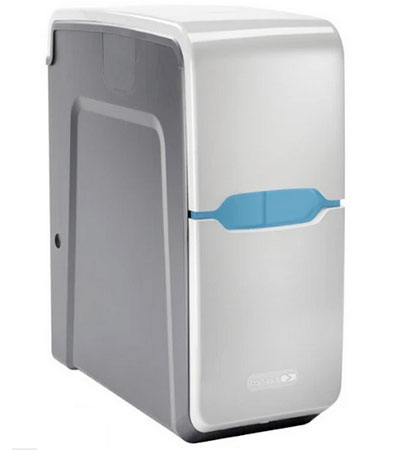
Kinetico Premier Compact Twin water softener
Non-Salt Water Softeners
Non-salt water softeners, also known as salt-free conditioners, don’t use salt or traditional ion exchange to soften water. Instead, they condition hard water to prevent mineral deposits and scale buildup in appliances.
These systems use Template Assisted Crystallization (TAC) to convert calcium and magnesium into hard crystals that won’t stick to surfaces. Because they don’t trap minerals, there’s no need for costly regeneration or salt, making them more economical to operate. Plus, the conditioned water is safe to drink.
Non-salt systems are energy-efficient, as they don’t require power or servicing. However, since they don’t remove minerals, you might still experience issues like soap inefficiency or a scummy film in beverages.
Despite these drawbacks, salt-free conditioners are a cost-effective and low-maintenance solution. A popular option is the Aquasana Rhino whole-house system, with prices ranging from £500 to £1,000.
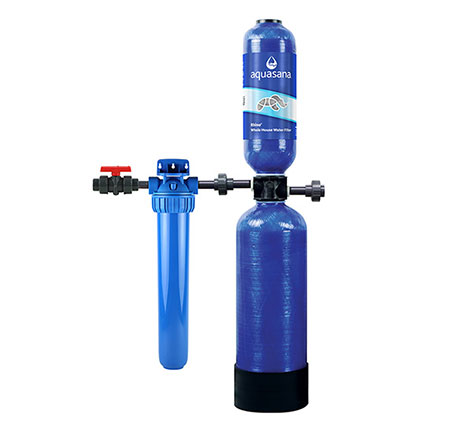
Aquasana Rhino whole house salt free water conditioner
Electronic/Magnetic Water Conditioners
Electronic and magnetic water conditioners don’t remove minerals from hard water but condition it to prevent limescale buildup. These devices work by generating a magnetic field around your main water pipe, altering the properties of the minerals to stop them from sticking to surfaces.
These units are typically small, rectangular boxes with wires that coil around the water pipe. Once connected to a power source, they create the magnetic field that conditions the water and prevents any deposits from settling.
Benefits of these systems include low maintenance, easy installation, and affordability, with prices ranging from £100 to £200.
A popular option is the Eddy water conditioner and scale inhibitor, which has received positive feedback from customers. For a step-by-step guide, check out our installation project and video below.
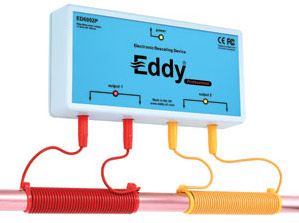
The Eddy hard water inhibitor and descaler
Choosing the Right Water Softener or Conditioner
Selecting the right water softener or conditioner depends on your budget, household size, and water usage.
If budget isn’t an issue, a salt-based water softener is effective but requires a separate drinking water tap due to raised sodium (salt) content. For those with moderate funds, a salt-free conditioner offers a good balance of performance and cost. If you’re looking for an affordable option, the Eddy system mentioned above is a solid choice and should yield good results.
For more tips on tackling hard water and reducing limescale, including a map of hard water areas in the UK, check out our guide on dealing with hard water.
Although hard water doesn’t pose a health risk, it does however damage appliances and the likes over time and can significantly shorten their lives, however there are certainly accessible and reasonably cheap DIY solutions that you can implement that can help to reduce hard water issues in your home.

